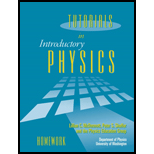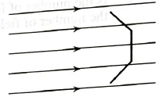
Tutorials In Introductory Physics: Homework
1st Edition
ISBN: 9780130662453
Author: Lillian C. McDermott, Peter S. Shaffer
Publisher: PEARSON
expand_more
expand_more
format_list_bulleted
Concept explainers
Textbook Question
Chapter 19.2, Problem 1bTH
Consider an imaginary surface in a uniform electric field

Expert Solution & Answer
Want to see the full answer?
Check out a sample textbook solution
Students have asked these similar questions
2
3
Imagine you are out for a stroll on a sunny day when you encounter a lake. Unpolarized light from the sun is reflected off the lake into your eyes. However, you notice when you put on your vertically polarized sunglasses, the light reflected off the lake no longer reaches your eyes. What is the angle between the unpolarized light and the surface of the water, in degrees, measured from the horizontal? You may assume the index of refraction of air is nair=1 and the index of refraction of water is nwater=1.33 . Round your answer to three significant figures. Just enter the number, nothing else.
Chapter 19 Solutions
Tutorials In Introductory Physics: Homework
Ch. 19.1 - Draw a separate free-body diagram for each ball....Ch. 19.1 - Suppose the charge on the second ball is reduced...Ch. 19.1 - Predict what will happen if the net charge on ball...Ch. 19.1 - How does Coulomb’s law apply to situations in...Ch. 19.1 - In cases A and B shown at right there are two...Ch. 19.1 - In case C, two positive point charges +2Q are each...Ch. 19.1 - In case E a positive point charge with +Q is a...Ch. 19.1 - Is the magnitude of FPgreater than, less than, or...Ch. 19.1 - Is the magnitude of the net force on +qgreater...Ch. 19.1 - A second negative point charge Q is placed as...
Ch. 19.1 - A thin semicircular rod like the one in problem 4...Ch. 19.1 - Sketch the charge distribution on the rod.Ch. 19.1 - Is there a non-zero net electric force on the rod?...Ch. 19.1 - Is there a non-zero net electric force on the...Ch. 19.1 - State whether the magnitude of the net electric...Ch. 19.2 - Prob. 1aTHCh. 19.2 - Consider an imaginary surface in a uniform...Ch. 19.2 - Write an expression for the net electric flux net...Ch. 19.2 - Prob. 2aTHCh. 19.2 - Prob. 2bTHCh. 19.2 - Consider the surface element A itself as composed...Ch. 19.2 - Consider the left side of the box as Consisting of...Ch. 19.2 - The loop is held to the right of a positive point...Ch. 19.2 - Prob. 3bTHCh. 19.2 - Suppose that the new charge located to the right...Ch. 19.3 - Prob. 1aTHCh. 19.3 - Prob. 1bTHCh. 19.3 - Suppose that the curved portion of the Gaussian...Ch. 19.3 - A Second point charge +q is placed to the right of...Ch. 19.3 - Sketch a vector at each of points AD to represent...Ch. 19.3 - Sketch a vector at each of points AD to represent...Ch. 19.3 - Sketch a vector at each of points AD to represent...Ch. 19.3 - Sketch the net electric field at each of points...Ch. 19.3 - Calculate the magnitude of the electric field at...Ch. 19.4 - A small test charge qo travels from point X to...Ch. 19.4 - Prob. 1bTHCh. 19.4 - Points B and C are a distance ro away from the...Ch. 19.4 - A large metal sphere with zero net charge is now...Ch. 19.4 - Draw arrows on the diagram to indicate the...Ch. 19.4 - A positively charged test particle moves from...Ch. 19.4 - A positively charged test particle moves from A to...Ch. 19.4 - Find the magnitude and direction of the electric...Ch. 19.4 - A particle of mass mo and charge qo is released...Ch. 19.5 - The Surface area of the face of each plate is AI ....Ch. 19.5 - A new capacitor is formed by attaching two...Ch. 19.5 - Find the charge density on the plates. Explain.Ch. 19.5 - Find the electric potential difference between the...Ch. 19.5 - Show that the capacitance of the enlarged plates...
Additional Science Textbook Solutions
Find more solutions based on key concepts
The following data were obtained from a disk-diffusion test. Antibiotic Zone of Inhibition A 15 mm B 0 mm c 7 m...
Microbiology: An Introduction
All of the following processes are involved in the carbon cycle except: a. photosynthesis b. cell respiration c...
Human Biology: Concepts and Current Issues (8th Edition)
A pure-breeding tall plant producing oval fruit as described in Problem 2 is crossed to a pure-breeding short p...
Genetic Analysis: An Integrated Approach (3rd Edition)
39. A square current loop 5.0 cm on each side carries a 500 mA current. The loop is in a 1.2 T uniform magnetic...
College Physics: A Strategic Approach (3rd Edition)
9. Blocks with masses of 1 kg, 2 kg, and 3 kg are lined up in a row on a frictionless table. All three are push...
Physics for Scientists and Engineers: A Strategic Approach, Vol. 1 (Chs 1-21) (4th Edition)
What type of unconformity separates layer G from layer F?
Applications and Investigations in Earth Science (9th Edition)
Knowledge Booster
Learn more about
Need a deep-dive on the concept behind this application? Look no further. Learn more about this topic, physics and related others by exploring similar questions and additional content below.Similar questions
- 20. Two small conducting spheres are placed on top of insulating pads. The 3.7 × 10-10 C sphere is fixed whie the 3.0 × 107 C sphere, initially at rest, is free to move. The mass of each sphere is 0.09 kg. If the spheres are initially 0.10 m apart, how fast will the sphere be moving when they are 1.5 m apart?arrow_forwardpls help on allarrow_forwardpls help on thesearrow_forward
- pls help on all asked questions kindlyarrow_forwardpls help on all asked questions kindlyarrow_forward19. Mount Everest, Earth's highest mountain above sea level, has a peak of 8849 m above sea level. Assume that sea level defines the height of Earth's surface. (re = 6.38 × 106 m, ME = 5.98 × 1024 kg, G = 6.67 × 10 -11 Nm²/kg²) a. Calculate the strength of Earth's gravitational field at a point at the peak of Mount Everest. b. What is the ratio of the strength of Earth's gravitational field at a point 644416m below the surface of the Earth to a point at the top of Mount Everest? C. A tourist watching the sunrise on top of Mount Everest observes a satellite orbiting Earth at an altitude 3580 km above his position. Determine the speed of the satellite.arrow_forward
- pls help on allarrow_forwardpls help on allarrow_forward6. As the distance between two charges decreases, the magnitude of the electric potential energy of the two-charge system: a) Always increases b) Always decreases c) Increases if the charges have the same sign, decreases if they have the opposite signs d) Increases if the charges have the opposite sign, decreases if they have the same sign 7. To analyze the motion of an elastic collision between two charged particles we use conservation of & a) Energy, Velocity b) Momentum, Force c) Mass, Momentum d) Energy, Momentum e) Kinetic Energy, Potential Energyarrow_forward
arrow_back_ios
SEE MORE QUESTIONS
arrow_forward_ios
Recommended textbooks for you

 Physics for Scientists and Engineers: Foundations...PhysicsISBN:9781133939146Author:Katz, Debora M.Publisher:Cengage Learning
Physics for Scientists and Engineers: Foundations...PhysicsISBN:9781133939146Author:Katz, Debora M.Publisher:Cengage Learning Principles of Physics: A Calculus-Based TextPhysicsISBN:9781133104261Author:Raymond A. Serway, John W. JewettPublisher:Cengage Learning
Principles of Physics: A Calculus-Based TextPhysicsISBN:9781133104261Author:Raymond A. Serway, John W. JewettPublisher:Cengage Learning Physics for Scientists and EngineersPhysicsISBN:9781337553278Author:Raymond A. Serway, John W. JewettPublisher:Cengage Learning
Physics for Scientists and EngineersPhysicsISBN:9781337553278Author:Raymond A. Serway, John W. JewettPublisher:Cengage Learning Physics for Scientists and Engineers with Modern ...PhysicsISBN:9781337553292Author:Raymond A. Serway, John W. JewettPublisher:Cengage Learning
Physics for Scientists and Engineers with Modern ...PhysicsISBN:9781337553292Author:Raymond A. Serway, John W. JewettPublisher:Cengage Learning College PhysicsPhysicsISBN:9781285737027Author:Raymond A. Serway, Chris VuillePublisher:Cengage Learning
College PhysicsPhysicsISBN:9781285737027Author:Raymond A. Serway, Chris VuillePublisher:Cengage Learning


Physics for Scientists and Engineers: Foundations...
Physics
ISBN:9781133939146
Author:Katz, Debora M.
Publisher:Cengage Learning

Principles of Physics: A Calculus-Based Text
Physics
ISBN:9781133104261
Author:Raymond A. Serway, John W. Jewett
Publisher:Cengage Learning

Physics for Scientists and Engineers
Physics
ISBN:9781337553278
Author:Raymond A. Serway, John W. Jewett
Publisher:Cengage Learning

Physics for Scientists and Engineers with Modern ...
Physics
ISBN:9781337553292
Author:Raymond A. Serway, John W. Jewett
Publisher:Cengage Learning

College Physics
Physics
ISBN:9781285737027
Author:Raymond A. Serway, Chris Vuille
Publisher:Cengage Learning
Electric Fields: Crash Course Physics #26; Author: CrashCourse;https://www.youtube.com/watch?v=mdulzEfQXDE;License: Standard YouTube License, CC-BY